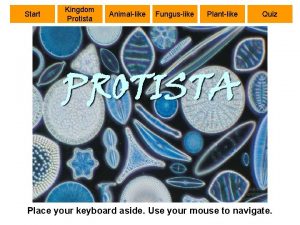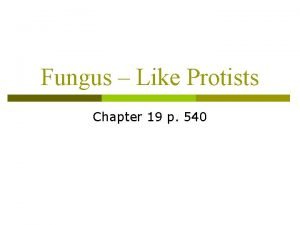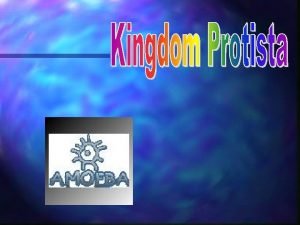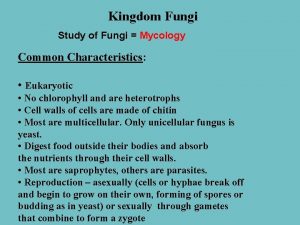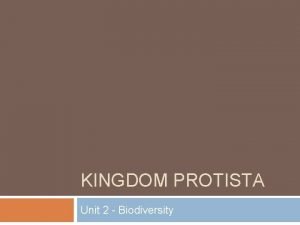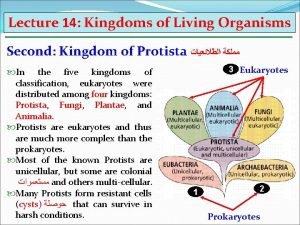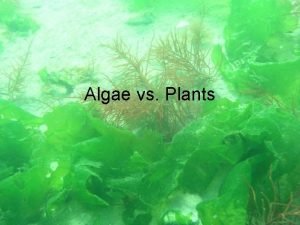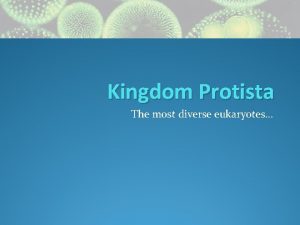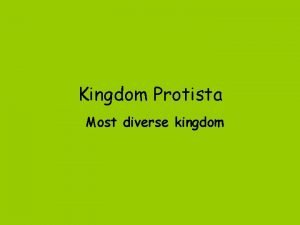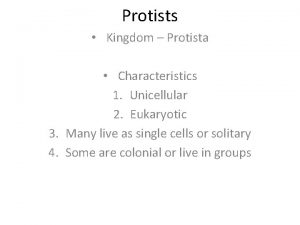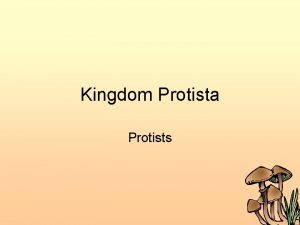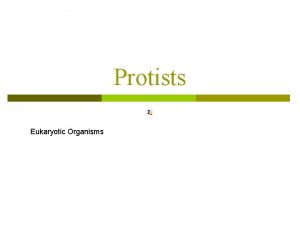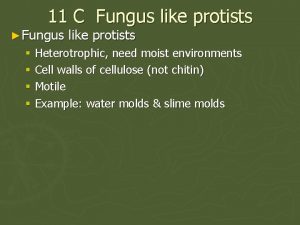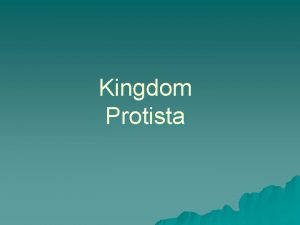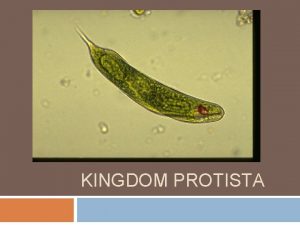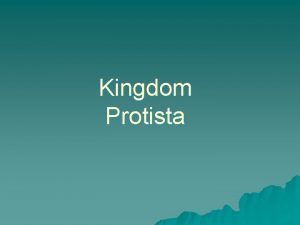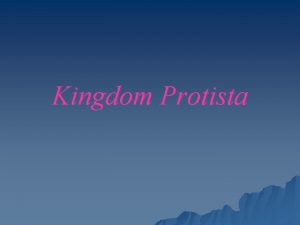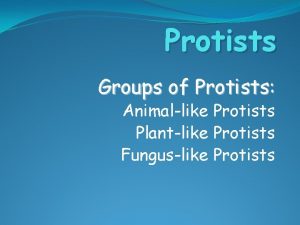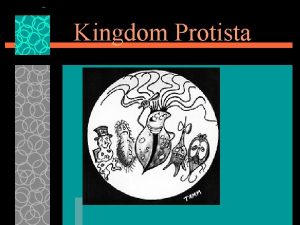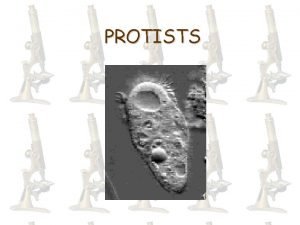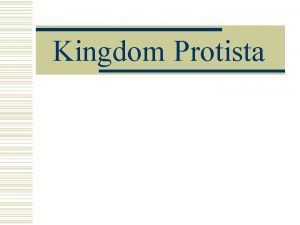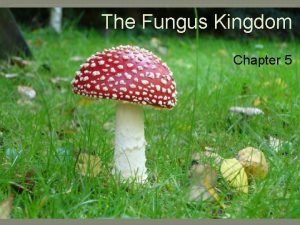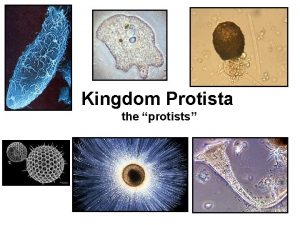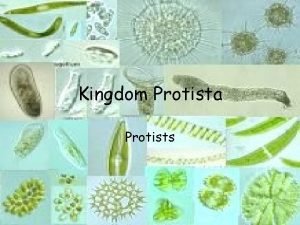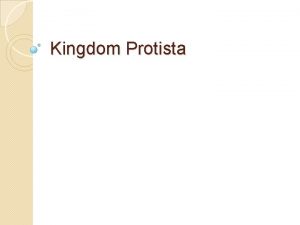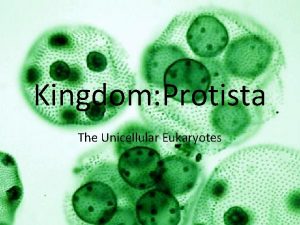Protists Fungus and Plants Kingdom Protista All Eukaryotic




















- Slides: 20

Protists, Fungus and Plants

Kingdom Protista All Eukaryotic (Have a nucleus) Most are Unicellular, some multicellular Classified based on MOVEMENT Either Autotrophs and Heterotrophs Some have cilia and others have a flagella (used for movement).

Animal-Like Protists Classified by the way they move!! Use either Cilia or Flagella's

Zooflagellate: Trichonymphia Lives in digestive system of termites Manufactures cellulase that makes it possible for termites to digest wood Mutualistic BENEFIT! Relationship with termites, both

Phylum Sarcodina (Sarcodines) o Move and feed by cytoplasmic extensions called pseudopods o Heterotrophic, some parasitic Ex: Amoebas

Phylum Ciliophora (Ciliates) o o Have short hair-like projections called cilia that are used for movement and feeding Heterotrophic, some parasitic

Plant-Like Protists (aka: Algae) ( Commonly called Algae) Contain chlorophyll and carries out photosynthesis

Kingdom Fungus Are Eukaryotic (have a nucleus), are heterotrophs and they have cell walls but they do NOT have chloroplasts.

How Fungi Eat… Fungus do not have mouths so they ABSORB food. They are decomposers-Many fungi feed on decaying organisms.

Groups of Fungi Common Molds- these include black bread mold Sac Fungi- largest group, include yeast, mildew and truffles. Yeast is used for baking and to brew beer.

Groups of Fungi Club Fungi- includes mushrooms and puffballs Imperfect Fungi- this fungus helps make PENICILLIN, an antibiotic used to treat some bacteria infections.

Lichens Are organisms that are made up of BOTH fungus and a green algae. Algae provide the fungus with energy, the fungus provides the algae with water and minerals. They share a mutualistic relationship, where both benefit.

Kingdom Plant Multicellular eukaryotes that have cell walls and chloroplast. They are autotrophs and make their food through photosynthesis.

What a Plant needs to Survive… Sunlight, water, minerals, gas exchange, transport of water and nutrients throughout the plant body. (stem, leaves, roots) 1 st evolved plant evolved from an organism like Green Algae.

Fill in Cladogram on Notes,

Groups of Plants Bryophytes- depend on water for reproduction, lack vascular tissue, draw up water through osmosis Examples: Mosses Seedless Vascular Plants- can move fluids through the plant body against gravity using xylem (brings water up) and phloem(sends nutrients to the leaves) ex: Ferns

Groups of Plants Gymnosperms- reproduce with seeds that are exposed, means “naked seed”. Ex: Conifers Angiosperms- have seed too, but they have flowers or fruits that holds the seeds. Ex: Roses Flowers –attract insects to help pollinate the plant and to help spread seeds to others plants. Fruit- is the ovary of the plant/tree that protects the seeds.

Root Types (anchors plants) Fibrous Root- no single root Taproot- long and thick with secondary small roots.

Leaf Function System that specializes in Photosynthesis (making food from sunlight), Transpiration (loss of water) and Gas Exchange (taking in carbon dioxide and releasing oxygen. Plants keep their Stoma open just enough to allow photosynthesis but not enough to lose excessive amounts of water. A lot of times they close at night or even close under really hot and dry conditions.

Stem Function Support for and the elevation of leaves, flowers and fruits. The stems keep the leaves in the light and provide a place for the plant to keep its flowers and fruits. Transport of fluids between the roots and the leaves using the xylem and phloem inside the stem. Storage of nutrients
 Kingdom plantae prokaryotic or eukaryotic
Kingdom plantae prokaryotic or eukaryotic Quiz 2: animal-like protists
Quiz 2: animal-like protists Fungus-like protists characteristics
Fungus-like protists characteristics Acrasiomycota characteristics
Acrasiomycota characteristics Old kingdom middle kingdom new kingdom
Old kingdom middle kingdom new kingdom Old kingdom middle kingdom new kingdom
Old kingdom middle kingdom new kingdom Youtube egypt
Youtube egypt Mentohotep
Mentohotep Giant kelp phylum
Giant kelp phylum Protista mobility
Protista mobility Protista
Protista Chytridiomycota examples
Chytridiomycota examples Protista
Protista Kingdom protists
Kingdom protists Algae vs plants
Algae vs plants Chrysophyta
Chrysophyta The most diverse kingdom
The most diverse kingdom Are plants eukaryotic
Are plants eukaryotic Are plants eukaryotic
Are plants eukaryotic Pyrophyta
Pyrophyta Respirasi protista
Respirasi protista

